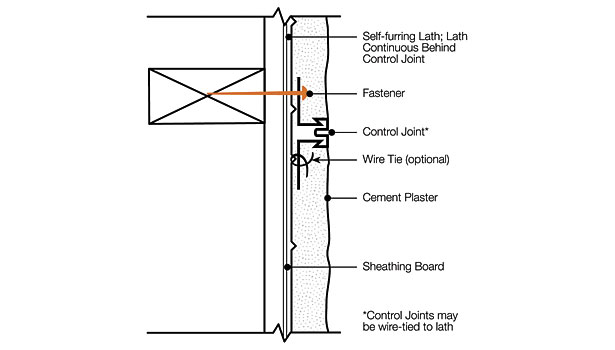STUCCO STOP
Preventing Cracks in Stucco
Controlling the Cracks

Single piece control joint

Control joint fastened to dual studs






As a kid and even as an adult, I admit I try not to step on the cracks between the blocks of sidewalks. Remember the old childhood chant, “Step on a crack and you’ll break your mothers back?” Did you know that those purposely aligned cracks are strategically placed to allow movement of the sidewalk without compromising the integrity? You see, concrete, a cement product, tends to crack in squares, so the “cracks” along the walk are placed at intervals to match the width of the walk (i.e., squares).
In our wall cladding industry, one may think of stucco as a thinner, vertical version of a poured-in-place concrete slab, which too, is subject to the “square-cracking” phenomenon. This thought is not necessarily correct. Our building code addresses stucco panel size and dimension in ASTM C-1063, Standard Specification for Installation of Lathing and Furring to Receive Interior and Exterior Portland Cement-Based Plaster.Specifically, sections 7.11.4.1 and 7.11.4.2 call out for maximum areas no larger than 144-square-feet and distances between control joints of no greater than 18 feet in either direction. Because the stucco is applied in a vertical plane, section 7.11.4.2 also allows a maximum length to width ration of 2½ to 1. So, if a contractor places the control joints at these intervals, can you expect no cracking? Probably not—but maybe.
Defining Control and Expansion Joints
First, let’s look at some definitions: A control joint is a single prefabricated stucco accessory, applied to the surface of—or incorporated within—the metal lath to allow for the shrinkage of the stucco cladding typically associated with the curing or hydration process. Control joints are not intended to accommodate structural movement of the wall assembly. Control joints can also act as architectural embellishments delineating texture differences or color changes. An expansion joint is a stucco accessory that accommodates movement beyond plaster shrinkage and curing, and minimal wall expansion and contraction. Expansion joints are usually a two-piece (back-to-back casing beads) or a manufactured slip-type, accessory and are fastened to the substrate, below the metal lath and weather resistive barrier.
Here is something for sure: If there is an expansion joint or structural break in the substrate, then one must place a stucco expansion joint to coincide with it. You cannot span over these with a control joint, a trowel cut in the stucco or any other “we-always-did-it-this-way” means of application. Hard and fast, you must use an expansion joint accessory. If you don’t, you are most certain to get an associated crack.
And for the not-so-sure: control joints may or may not always function to inhibit cracking. (They always perform well as screeds and architectural embellishments, though.) I know this sounds controversial but what is to follow is based on many years of applying and looking at stucco claddings. I’ll state it: stucco cracks do not mean they’re flawed, applied wrong or an incorrect cladding choice—they just are.
Why Cracking Happens
Let’s step away from the control joint for a minute and look at why some cracking occurs. If the exterior sheathing is not gapped around all of the edges, here’s your crack. If the roofing contractor loads the cement or asphalt shingles, if the drywall contractors hangs the drywall, if the earth movers pummel the ground near your job, after you have browned—here’s your crack and you get the gist of it. There are many influences that occur on every job that can affect the integrity of a stucco cladding; most can lead to cracking. But I digress as I’m sure most of the quality applicators have already figured these issues out. So, let’s get back to the control joint.
As we know, the control joint is intended to accommodate the shrinkage of the cement cladding during curing and in some instances can absorb some minor lineal movement. It is usually applied to the top of the metal lath and is either wire tied on both edges or fastened to a framing member along one edge and wire tied along the other. The stucco netting it is fastened to is manufactured in rolls of approximately 150 feet in length. When applied to the wall, stucco netting is usually run in a continuous manner—that is, there is a 150-foot run of woven wire, pulled taut and fastened at every framing member. Applied properly, it gives a certain tautness to the exterior wall. Metal laths, like expanded and welded wire, come in roughly 8-foot pieces and span about six studs when run horizontally. Again, like the woven wire, metal lath provides lateral strength and tautness, to the exterior wall.
Extra Movement
ASTM 1063 – 7.10.1.5 states that, “lath shall not be continuous through control joints but shall be stopped and tied at each side.” So unless there is a back-to-back stud for the fastening of the control joint and cut edge of the metal lath, there is going to be some “extra” movement on one side of the control joint. I am not advocating ignoring the ASTM standard, just stating that any code jurisdiction can allow the application of a control joint over an uninterrupted metal base as an alternate means of application. In fact, our technical associations here in the West acknowledge the placement of control joints over uncut metal lath bases when back-to-back studs are not in alignment with the control joint. There is long-standing success using this application method.
Here is where my experience lends to my belief that the cutting of the metal lath is not necessarily a cracking panacea: I applied stucco for many years in New Mexico throughout the whole state. The architecture there is Pueblo style, which mimics the Adobe structures of yore. Back in the day, they just didn’t put expansion joints—or any breaks—in the Adobe. The walls, which usually weren’t long in length, were only interrupted by vigas, windows, doors and rifle shooting-holes.
The Difference
This Pueblo style has remained an architectural staple and even though they are now mostly built with modern stick framing and stucco, the control joint or break is not desired at all. (I can recall many single-story buildings with no control or expansion joints in them and with little to no cracking in the stucco.) Of course, we always placed expansion joints at the structure joints and floor lines, but rarely did we use control joints in the field. Conversely, when I was a plastering newbie in Arizona, most structures had expansion joints above each window, door and wall fenestration and on long walls (usually no section longer than 12 feet). I distinctly remember cleaning out all of the joints because I was the float guy—what a pain. We used to carry sticks with a nail driven through them as clean-out tools because margin trowels ended up rounded at the tips. There was still some cracking in the stucco, some even near the control joints (the practice then was to always cut the wire behind them). Looking back and comparing both situations, I cannot recall one performing better than the other.
Stucco behaves differently than a cement sidewalk. The big difference, other than the orientation, is the addition of the continuous metal lath. So consider that it is quite possible to not necessarily have to place a bunch of lineal cracks in stucco to meet your building design needs. I believe a well-mixed stucco, properly floated and wet cured, applied over a continuous metal lath will perform as intended with minimal or—in some instances without—control joints.
Looking for a reprint of this article?
From high-res PDFs to custom plaques, order your copy today!








